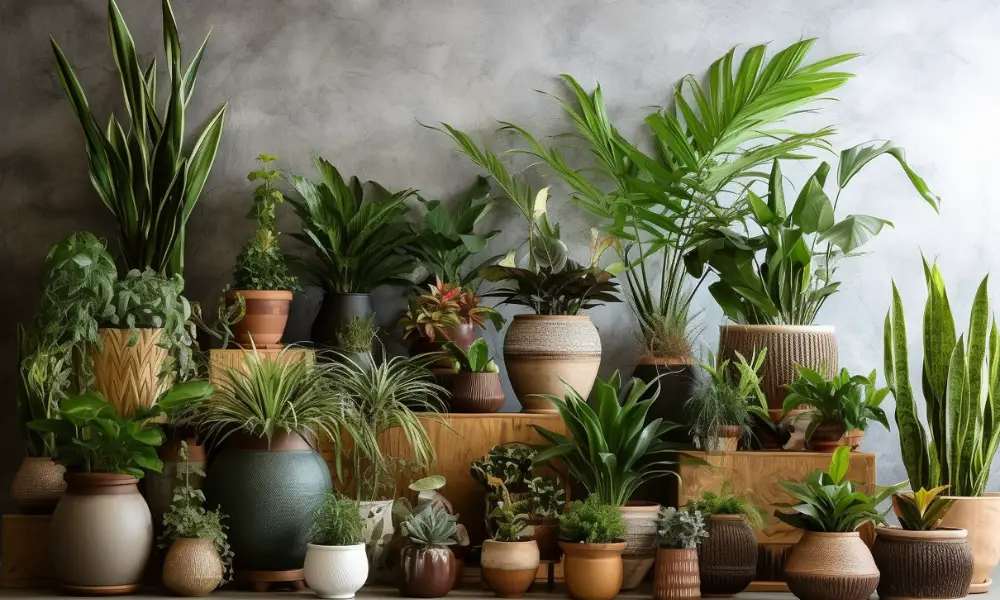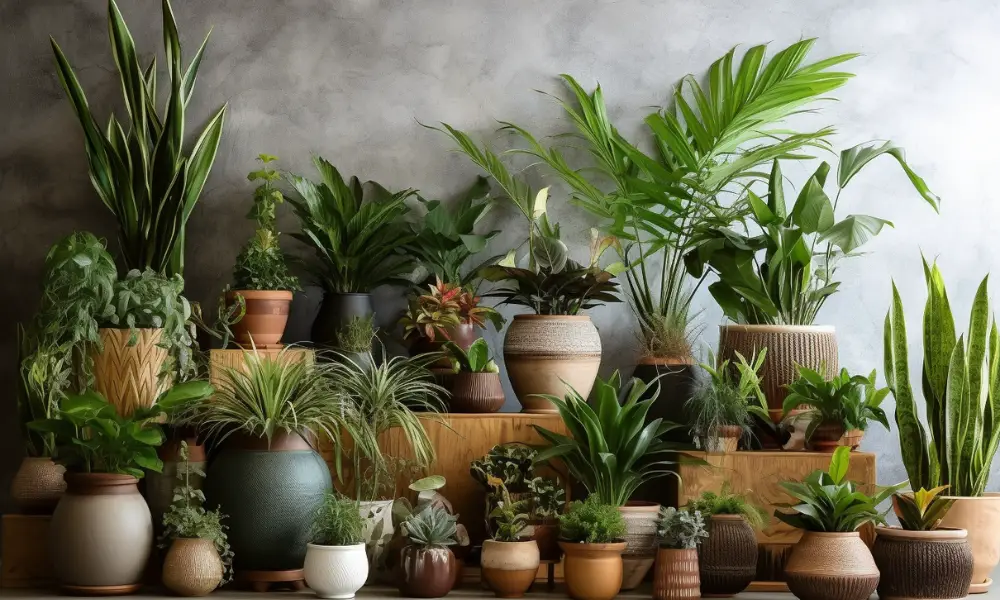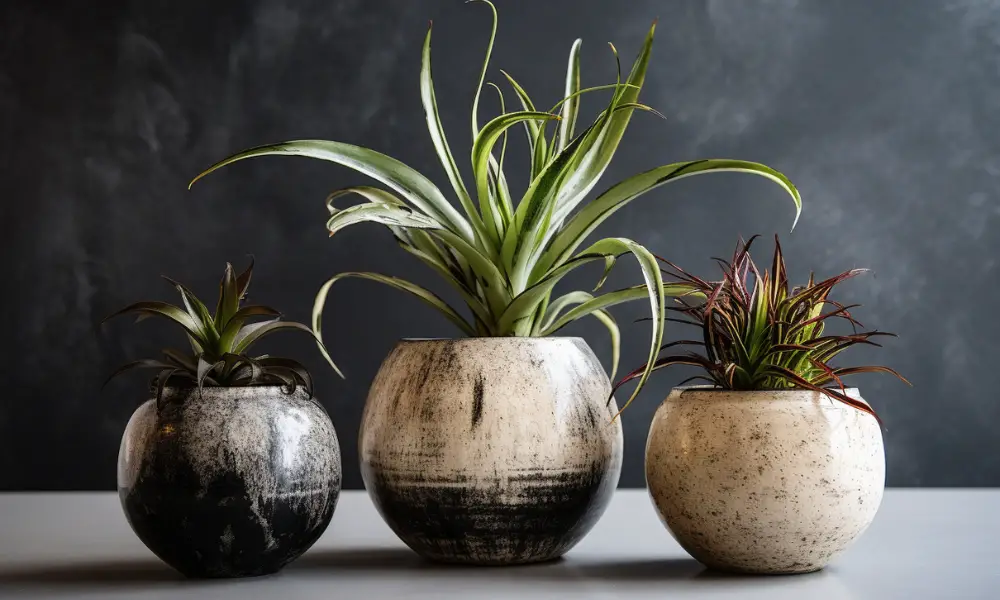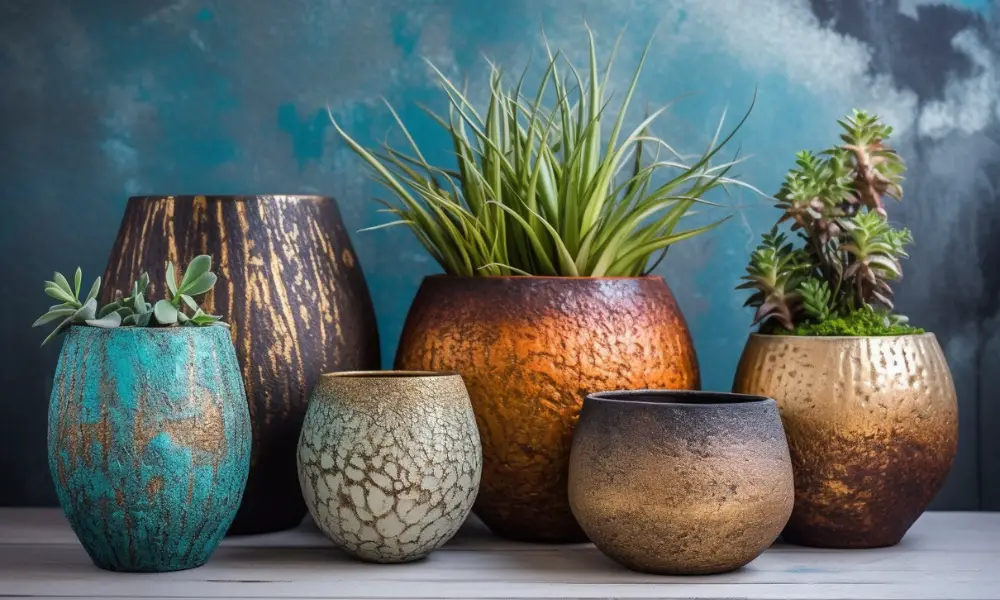Choosing the right pot material for repotting houseplants is a critical factor in maintaining their health and promoting growth. With over 390,000 known plant species on Earth and an ever-growing popularity of indoor gardening, understanding the characteristics of various pot materials is essential to ensure the well-being of your houseplants.
In this comprehensive guide, we’ll explore the most common pot materials, including terracotta, ceramic, plastic, metal, glass, wood, and fabric, examining their unique attributes, pros, and cons. Armed with this knowledge, you’ll be able to make informed decisions when repotting your houseplants, fostering their optimal growth and vitality.
What are the different pot materials available for repotting houseplants?

Houseplant enthusiasts have a plethora of pot materials to choose from, each with its own set of advantages and disadvantages. But there are 7 most commonly used materials and we will focus on these in our discussion. Let’s dive into the most common pot materials and their attributes.
| Material | Insulation | Weight | Moisture Retention | Durability | Aesthetic Appeal |
|---|---|---|---|---|---|
| Ceramic | Excellent | Heavy | Good (glazed) / Moderate (unglazed) | Moderate (prone to cracking) | Wide range of designs and colors |
| Plastic | Fair | Light | Good | Moderate (can become brittle) | Wide variety of colors, shapes, and sizes |
| Terracotta | Good | Heavy | Moderate | Moderate (prone to chipping) | Natural, earthy appearance |
| Metal | Poor | Light to moderate | Fair | Good (except for rusting) | Stylish and available in various designs |
| Wood | Excellent | Moderate to heavy | Good | Moderate (can rot if not treated) | Natural, rustic appearance |
| Fabric | Fair | Light | Moderate | Good (reusable) | Limited designs and styles available |
1. Terracotta
Terracotta, a classic and widely-used pot material, is known for its earthy appearance and porous nature. But how does this material impact your houseplants?
Terracotta’s porous nature allows for excellent root aeration, helping to prevent root rot. This is particularly beneficial for plants that require well-drained soil, as the material naturally wicks away excess moisture.
Terracotta pots can be quite heavy, especially when filled with soil and plants. While their weight provides stability for larger plants, it can also make them difficult to move and more prone to breaking if dropped.
Many plant lovers appreciate terracotta’s natural, earthy appearance. Over time, a patina will develop on the pot’s surface, adding character and charm.
Pros and cons of terracotta pots
- Pros: Promotes root aeration, prevents root rot, and offers stability
- Cons: Requires frequent watering, heavy, and breakable
2. Ceramic
Ceramic pots are popular for their beautiful designs and insulating properties. But how do they fare when it comes to houseplant health?
Ceramic pots are known for their ability to keep soil temperature stable, which is beneficial for many plants. However, their slow drying nature can be problematic for plants that are sensitive to overwatering.
Like terracotta, ceramic pots are heavy and can provide stability for larger plants. However, their weight also makes them more difficult to move and prone to chipping.
Ceramic pots come in a wide range of colors, patterns, and shapes, allowing you to find the perfect pot to complement your houseplants and interior design.
Pros and cons of ceramic pots
- Pros: Stable soil temperature, visually appealing, and supports larger plants
- Cons: Risk of overwatering, heavy, and prone to chipping
3. Plastic
Plastic pots are a lightweight, budget-friendly option for repotting houseplants. Let’s explore the pros and cons of this widely-used material.
One of the primary advantages of plastic pots is their light weight, making them easy to move and transport. However, this also means they may not provide adequate support for top-heavy plants.
Plastic pots are non-porous, which means they retain moisture longer than porous materials like terracotta. While this can be an advantage for some plants, it can also lead to poor aeration and root rot if the pot doesn’t have proper drainage.
Plastic pots are a budget-friendly option and are resistant to chipping and breaking, making them a durable choice for many plant owners.
Pros and cons of plastic pots
- Pros: Easy to move, retains moisture, budget-friendly, and durable
- Cons: Insufficient support for top-heavy plants and poor aeration
4. Metal
Metal pots can make a striking statement in your home, but how do they impact the health of your houseplants?
Metal pots are known for their rapid heating and cooling properties. This can be both an advantage and a disadvantage, depending on the specific needs of your houseplants. Some plants may benefit from the quick temperature changes, while others could suffer if the soil becomes too hot or cold.
Metal pots are prone to rust and corrosion, especially if they’re frequently exposed to moisture. To protect your plants and prolong the life of your metal pots, it’s essential to use a liner or choose pots made from rust-resistant materials like stainless steel or aluminum.
Metal pots can make a bold statement with their modern, industrial look. They come in various finishes and colors, allowing you to find the perfect fit for your space.
Pros and cons of metal pots
- Pros: Rapid heating and cooling, visually striking, and durable
- Cons: Prone to rust, risk of overheating, and may require insulation
5. Glass
Glass pots can provide a unique, eye-catching display for your houseplants. However, there are some factors to consider when choosing glass pots for your plants.
The transparency of glass pots allows you to easily monitor your plant’s root growth and soil moisture. However, this can also lead to algae growth if the pot is exposed to too much sunlight.
Glass pots tend to be quite heavy, which can provide stability for your plants but also make them more challenging to move.
Glass pots typically retain more moisture than other materials, which can be beneficial for plants that enjoy consistently moist soil. However, it’s essential to ensure proper drainage to prevent root rot.
Pros and cons of glass pots
- Pros: Visually appealing, encourages root growth, and easy to monitor soil
- Cons: Fragile, heavy, and risk of algae growth
6. Wood
Wooden pots offer a natural, rustic appeal, but how do they fare when it comes to supporting houseplant health?
Wooden pots provide natural insulation, helping to maintain a stable temperature within the soil. This can be especially beneficial for plants that prefer consistent temperatures.
Wooden pots offer a warm, organic look that can complement various interior styles. They’re also an environmentally-friendly option, especially when made from sustainably sourced materials.
Wooden pots can be susceptible to rot and pest infestations, especially when exposed to moisture. Regular maintenance, including sealing and treating the wood, can help prevent these issues.
Pros and cons of wood pots
- Pros: Provides insulation, visually pleasing, and environmentally friendly
- Cons: Risk of rot, pest infestation, and may require regular maintenance
7. Fabric
Fabric pots, often referred to as grow bags, are an unconventional but effective option for repotting houseplants. Let’s explore their unique attributes.
Fabric pots are highly breathable, promoting excellent root aeration and preventing root rot. This makes them an excellent choice for plants that require well-drained soil.
Fabric pots are lightweight and easy to move, making them a convenient option for plant owners who frequently rearrange their plant displays.
While fabric pots may not be as sturdy as other materials, they are typically made from durable materials like felt or canvas, allowing them to withstand regular use.
Pros and cons of fabric pots
- Pros: Promotes root aeration, lightweight, and easy to store
- Cons: May require more frequent watering and less sturdy compared to other materials
How to choose the best pot material for specific houseplant needs?

With a variety of pot materials to choose from, it’s essential to consider your plant’s unique needs when selecting the right material.
Assessing the plant’s water requirements
Understanding your plant’s water requirements is crucial when selecting the right pot material. Some materials, like terracotta and fabric, are better suited for drought-tolerant plants, while others, like plastic and glass, are ideal for moisture-loving plants.
1. Matching pot materials to moisture-loving plants
If your plant enjoys consistently moist soil, consider materials like plastic or glass that retain moisture longer. Be sure to monitor the soil and ensure proper drainage to prevent root rot.
2. Choosing the right pot material for drought-tolerant plants
For plants that prefer well-drained soil, opt for materials like terracotta or fabric that promote root aeration and prevent overwatering.
Considering the plant’s size and growth habits
The size and growth habits of your houseplant will also impact your choice of pot material. Consider factors such as stability, support, and proper root development when selecting the appropriate material.
1. Selecting the appropriate pot material for stability and support
Large, top-heavy plants require a stable pot to prevent tipping. In these cases, opt for heavier materials like terracotta or ceramic that provide stability and support.
2. Ensuring the pot material allows for proper root development
Choosing a pot material that promotes healthy root development is essential for your plant’s overall health. Materials like terracotta, fabric, and wood offer excellent aeration and encourage proper root growth.
Factoring in the plant’s environment and placement
The environment and placement of your houseplant should also influence your choice of pot material. Consider the surrounding décor, aesthetics, and whether the pot will be placed indoors or outdoors.
1. Matching pot materials with the surrounding décor and aesthetics
Select a pot material that complements your interior design and the aesthetic you want to create. For instance, choose a sleek metal pot for a modern, industrial vibe, or opt for a wooden pot for a more natural, rustic look.
2. Choosing a pot material suitable for outdoor or indoor conditions
Consider whether your pot will be exposed to outdoor elements or kept indoors. Some materials, like wood and metal, may require additional maintenance and protection when used outdoors, while others, like plastic and ceramic, are more suitable for both indoor and outdoor use.
What are the essential features to look for in a pot for repotting houseplants?

When selecting a pot for your houseplant, there are a few key features to consider, regardless of the material.
1. Proper drainage
Good drainage is essential for maintaining healthy houseplants. Look for pots with drainage holes or consider alternative drainage systems, like using a layer of gravel at the bottom of the pot.
2. Adequate size
Choosing the right size pot is crucial for your plant’s growth and well-being. Ensure there’s enough room for root growth but avoid pots that are too large or too small, as this can lead to various issues.
3. Compatibility with saucers or trays
Using a saucer or tray under your pot can help control moisture and protect surfaces from water damage. When selecting a pot, consider its compatibility with saucers or trays and choose the right size and shape for your chosen pot material.
Tips for repotting houseplants in various pot materials

Regardless of the pot material you choose, following proper repotting techniques is crucial for your houseplant’s health and happiness.
Preparing the pot and plant for repotting
Before repotting, clean the pot thoroughly and inspect your plant’s roots, removing any dead or damaged parts. It is important to avoid root damage during repotting.
Techniques for repotting in different pot materials
When repotting, consider the unique attributes of your chosen pot material. For instance, be cautious when repotting in terracotta, ceramic, and glass pots, as they can be heavy and fragile. On the other hand, when repotting in plastic, metal, wood, or fabric pots, ensure proper drainage and aeration to prevent root rot and maintain plant health.
Post-repotting care
After repotting your houseplant, monitor its watering and fertilizing requirements, as they may change with the new pot material. Keep a close eye on your plant’s health and adjust its care as needed.
